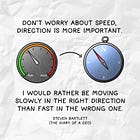Just Stop Trying
The Success of Non Action
Welcome to Polymathic Being, a place to explore counterintuitive insights across multiple domains. These essays explore common topics from different perspectives and disciplines to uncover unique insights and solutions.
Today's topic weaves together philosophy and physiology to explain how our best efforts are sometimes the cause of our failure. We’ll examine the concept of reversed effort, wu wei, and the art of not trying to achieve the success we want. Buckle in!
Intro
Where do I get the ideas for the things I write about? Well, it’s from readers like you who comment, engage, and challenge. For example, Chris Guest recently wrote a note asking me to explore the Law of Reversed Effort. It’s a great idea and a fun topic and we decided he should help co-author. Without further ado, let’s dive into the philosophical and physiological implications of doing nothing to succeed.
“The harder we try with the conscious will to do something, the less we shall succeed.” This is known as The Law of Reversed Effort and was coined by Aldous Huxley in The Art of Seeing, published in 1942. He’s describing how he retrained his eyesight after noticing that straining to see (screwing up the eyes, holding the breath, tensing the neck) reduced visual clarity. Instead, relaxing attention and letting the process happen automatically allowed his eyes to focus better.
It’s not a new idea and has a long legacy, specifically in the Taoist philosophy of Wu Wei, where stories like Butcher Ding from the 4th century BCE tell of a cook who carves an ox so effortlessly that his knife “hasn’t needed sharpening in nineteen years.” It highlights the idea of effortless flow achieved through mastery compared to the amount of force a novice applies to a problem.
Hinduism’s Samatva-Yoga (“Yoga of Equanimity”) from Bhagavad Gītā 2.48 advises a middle stance, reminding adherents that yoga is not the postures, nor a trance in the Himalayas, but the capacity to stay balanced while acting in the heat of life. Buddhism’s Middle Way offers a similar example, as the Buddha, after years of punishing asceticism, relaxed into moderation and attained enlightenment beneath the Bodhi tree. He succeeded by not trying to achieve success.
The Western canon has similar tales, such as the Arthurian legend of the sword in the stone, where Knights heave with all their might, while young Arthur pulls the blade without strain because he isn’t trying to prove anything. Another is Aesop’s fable, The Wind and the Sun, where the wind’s force stiffens the traveller’s grip on his cloak compared to the sun’s gentle warmth that causes him to remove it freely. Even the adage, “A watched pot never boils,” and the investing advice “it’s not timing the market but time in the market,” capture the idea of reversed effort. Now, let’s pivot to some personal stories.
🎧Prefer to listen? You can find these essays on all major podcast players!
Personal Anecdotes
Chris Guest here: For 15 years, I was obsessed with trying to win an advertising award, meticulously crafting complex campaigns that consistently failed to impress. My breakthrough arrived unexpectedly in 2010 while working on a Fiat campaign. A media agency proposed a technologically convoluted idea to link music on Spotify to car configurations. My spontaneous counter-suggestion was to simply create the "world's biggest happy music playlist" using user-submitted songs. The idea was met with immediate enthusiasm from everyone, including Spotify, despite the technical challenge of creating collaborative playlists at the time.
This simple idea, promoted as the "happiest playlist in the world," resonated strongly with customers and, more importantly, with the marketing industry. Months later, I was collecting an award from The Guardian for the campaign. The irony was that the win felt hollow, almost undeserved, as the idea hadn't been the result of my usual over-engineered efforts but had "rolled off my tongue."
The irony deepened as creative directors and judges praised the campaign's simplicity, contrasting it with the complex, often impenetrable submissions they usually received. This experience profoundly shifted my understanding of effective marketing, solidifying the timeless principle of "keep it simple, stupid."
Back to Michael: I’ve written before in Slow Is Smooth and Smooth Is Fast about how Wu Wei applied to my time in the Army, so today, I’ll focus on my professional career. I’ve got a big personality, and I was motivated. However, I wasn’t having the success I wanted. I loved helping to lead collaborations and would often stand near a whiteboard to capture everyone’s insights and help weave them into a solution. However, no matter how profound the outcome, I’d constantly get negative feedback.
One day, a mentor of mine told me just to sit down and, if I wanted to use the whiteboard, to ask if everyone was OK with that. I was baffled because I intended to collaborate, but I learned that a 230lb, 6’6” former Army Ranger moving at 120mph wasn’t as collaborative in the business world as I thought it was. When I took my foot off the gas pedal, I found that I went faster, people were happier, and my feedback was more positive. Sitting down was the physical manifestation of a mental deceleration.
The historical philosophies and personal stories aren’t just anecdotes. The idea of Wu Wei and Reversed Effort has a physiological underpinning that we’ll explore next.
Physiologically:
Our bodies are wired for an action-response-reaction cycle. It’s not just our brains; it’s our entire endocrine system flowing through our limbic brain, and finally connecting to our prefrontal cortex. When they work together, we flow. When we try too hard, these systems create tangles and blocks that hinder our flow. For example:
We have competing neural systems where self-monitoring recruits the prefrontal cortex, overriding faster, automated circuits in the basal ganglia and cerebellum that govern skilled action. This pressure leads to “choking,” as shown by explicit-monitoring research in sports psychology.
Arousal overshoot, demonstrated by the Yerkes-Dodson curve, shows performance rises with arousal only up to an optimum level and, beyond that, extra effort adds anxiety and degrades output.
Focusing on outcome (“I must hit the ball”), instead of process or sensation, steals bandwidth needed for fluid execution, a phenomenon Timothy Gallwey illustrated in The Inner Game of Tennis.
These address just a few of the physical underpinnings of Reversed Effort and how deeply ingrained it is in our brains and bodies. Now, while it’s great to understand the theory, let’s look at how to minimize your effort:
Practical Application
First, remember, Slow is Smooth and Smooth is Fast. This is the foundation and gives you permission to take a deep breath and slow down for the rest of these suggestions:
Notice tension first; Where does the “trying” live in your body? Is it in your jaw, shoulders, or breath? Then work to release that tension.
Shift your attention outward by anchoring on sound, rhythm, or the ball, rather than focusing on yourself doing the action.
Use inversion by deliberately doing the opposite for a moment. Envision defeat, focus on failure, and how it happens, and then reset your mind.
Trust your automatic system by recalling times you succeeded while relaxed; give yourself the benefit of the doubt and let your body take over from your brain.
Let evaluation lag. Perform now, analyse later; stop judging before action.
As a final example, let’s loop back to the intro on where the ideas for essays like this come from. This one is a perfect example of the Law of Reversed Effort. Instead of thinking that all these ideas need to come from my own brain, experience, and effort, I stepped back and allowed ideas to flow from all around me.
From Chris’s original note to the point where I put my pen down at 90% complete, it took less than an hour in total due to reversed effort. It also harnessed Wu Wei, where it achieved a fusion and confluence of ideas that allowed the words to flow because the basics had already been mastered.
Truthfully, the less I do and the more I let others’ ideas flow around me, the easier my writing becomes, and the more people I involve, the faster Polymathic Being grows.
Summary
The Law of Reversed Effort is about as counterintuitive as you can find, but also deeply rooted in philosophical traditions from around the world. The hard part, like any good philosophy, is to apply it to our lives. The best approach is to take a tactical pause, recognize that intentional non-action can be a helpful tool, and identify where your effort isn’t working.
The next step is ‘simple:’ stop putting effort there and see what happens next. Sometimes you find that what you thought would fall apart doesn’t. Sometimes it will fall apart, and you realize the consequences you imagined didn’t happen. Sometimes you realize you do need to keep making an effort, for now, until you find a better way. Just Stop Trying is permission to take the first steps in ensuring your effort is investigated, impactful, and intentional.
Did you enjoy this post? If so, please hit the ❤️ button above or below. This will help more people discover Substacks like this one, which is great. Also, please share here or in your network to help us grow.
Polymathic Being is a reader-supported publication. Becoming a paid member keeps these essays open for everyone. Hurry and grab 20% off an annual subscription. That’s $24 a year or $2 a month. It’s just 50¢ an essay and makes a big difference.
Further Reading from Authors I Appreciate
I highly recommend the following Substacks for their great content and complementary explorations of topics that Polymathic Being shares.
Goatfury Writes All-around great daily essays
Never Stop Learning Insightful Life Tips and Tricks
Cyborgs Writing Highly useful insights into using AI for writing
Educating AI Integrating AI into education
Socratic State of Mind Powerful insights into the philosophy of agency









This reminds me of the epitaph on Charles Bukowski’s tombstone: “Don’t Try.”
Helpful explanation to a potent concept. I most often experience this inadvertently when I “give up” on something (usually taking a break) only to then have the success I sought. Thanks.